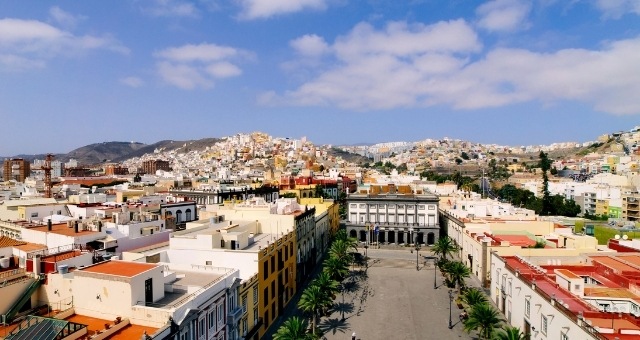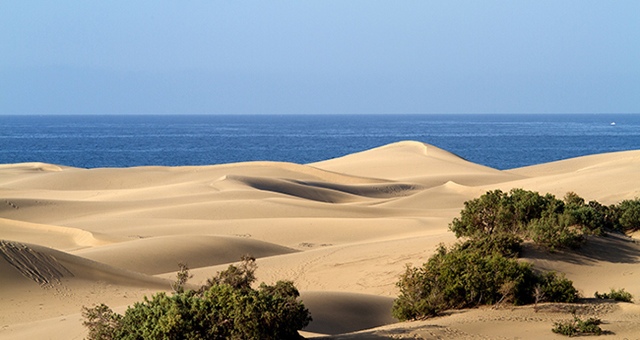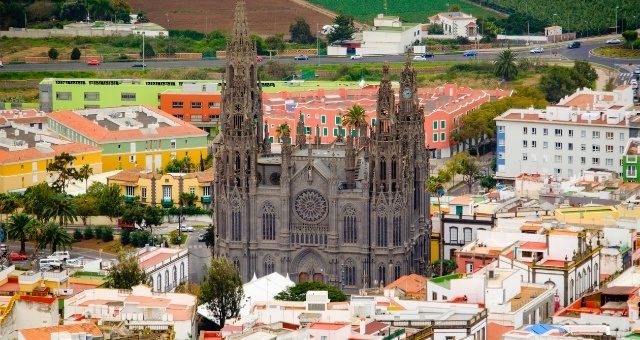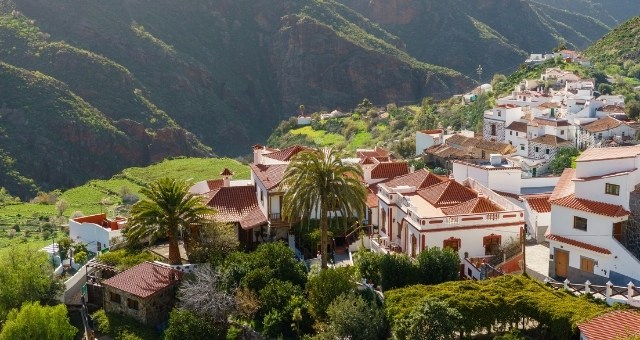Gran Canaria
Canary Islands, SpainGran Canaria is one of the top destinations in the Canaries. With its gorgeous beaches, diverse landscape and wide range of activities and attractions, the popular island has something for everyone.
In our Gran Canaria travel guide, you will find all the information you need about your holidays: the best things to do, top beaches, sights, food, and ferry schedules. Book cheap ferry tickets online to Gran Canaria on Ferryhopper hassle-free!

The beautiful square of Santa Ana in Las Palmas, the capital of Gran Canaria
Holidays in Gran Canaria
Gran Canaria is the third largest of the Canary Islands. It is also known as the "miniature continent" due to the impressive diversity of its landscape. Even though it is renowned for its amazing beaches, Gran Canaria will also enchant you with its beautiful mountains, sand dunes, lush vegetation, and dark volcanic earth.
Like all the Canary Islands, Gran Canaria is blessed with year-round warm weather. This is why it's an ideal destination for enjoying the great outdoors. Indeed, the island offers a huge range of water sports and outdoor activities for everyone.
Gran Canaria's lively capital Las Palmas and the island's big tourist resorts have all the modern amenities that travelers might need. But if you're looking for something more quiet, Gran Canaria won't disappoint you. In the island's peaceful inland villages, you can discover the more traditional way of life of Gran Canaria's inhabitants.
Tip: the carnival of Las Palmas de Gran Canaria is one of the oldest in the Canary Islands. If you visit Gran Canaria during that time, you will find the streets of the capital filled with music and color, as costume parades and endless parties take place throughout the city! You can find out more about festivals in the Canary Islands in our dedicated blog.
How to get to Gran Canaria
You can easily reach Gran Canaria by ferry or plane.
You can take the ferry to Gran Canaria either from Huelva or Cádiz in mainland Spain. Both cities are located on the southwestern coast of the country. Ferry crossings from Huelva are more frequent, with 3 departures per week to Gran Canaria. All ferries from mainland Spain arrive at the port of Las Palmas de Gran Canaria. You can also travel by ferry to Gran Canaria from some of the other Canary Islands.
Planning to travel to Gran Canaria? You can find more information about ferry schedules and tickets to Gran Canaria below.
Alternatively, Gran Canaria has one international airport, located approximately 19 km from the center of Las Palmas and 25 km from Maspalomas. Several bus routes connect the airport to the capital and the major towns and resorts in Gran Canaria.

The heavenly Maspalomas beach with its impressive sand dunes
What to do in Gran Canaria
Looking for things to do in Gran Canaria? There are so many amazing attractions, activities and places to visit, that you would have to spend several weeks on the island to fully experience what it has to offer.
Apart from swimming in the crystal-clear waters, you should not miss the opportunity to explore the unique natural sights and historical monuments to learn more about the island's past.
During your Gran Canaria holidays, it is also worth visiting the rural villages to marvel at the beautiful architecture and try local delicacies. And last but not least, Gran Canaria hosts several cultural events as well as the Carnival of Las Palmas, one of the most famous carnivals in Spain!
Sounds exciting? Keep reading our travel guide to Gran Canaria to find out all you need to know about your holidays, including what to see in Gran Canaria, the best things to do, tips, and useful information.
Beaches in Gran Canaria
Gran Canaria boasts over 230 km of coastline, with stunning beaches making up more than a quarter of it. The south of the island has warmer weather. That is where you will find the biggest and most popular beaches with golden sand and calm waters. Most of them are linked to tourist resorts, which means that they offer several amenities for visitors but can get quite busy. Beaches in the north and the west are more wild and free.
Some of the best beaches in Gran Canaria are:
- Maspalomas: the unique Sahara-style sand dunes of Maspalomas are one of the most famous attractions in Gran Canaria. The magical beach is about 6 km long, so it never really feels crowded even though it is very popular. While there are amenities such as sun-loungers, umbrellas, beach bars, and water sports facilities, you will also find quieter spots to relax. There is a nude-friendly section in the middle of the beach, next to the largest sand dunes.
- Las Canteras: located right next to the center of Las Palmas de Gran Canaria, this long sandy beach with calm waters is close to all the capital's amenities and has a nice local feel. It is great for swimming and snorkeling, as the whole beach is a marine reserve. There are also several restaurants that serve fresh fish, as well as surf and diving schools. Bear in mind that Las Canteras beach can get crowded during peak season.
- Aguadulce: located on the east coast of the island, this small pristine beach has golden sand and beautiful turquoise waters. Clothing is optional and there are no amenities.
- Mogán: this is the beach of Puerto de Mogán, a popular resort on the southwest coast of the island. The beach is sandy and sheltered with calm waters, so it is perfect for kids. The location is beautiful and visitors have easy access to all the shops and restaurants of the picturesque fishing village. There are also paddle boat and canoe rentals.
- Amadores: located on the southwest coast, this is an idyllic beach with white sand and amazing turquoise waters. It is sheltered from the wind and has lifeguards, which makes it ideal for families. Amadores beach also has several amenities, such as umbrellas, sun-loungers, bars, restaurants, and water sports facilities.
- Puerto Rico: this is the beach of lively and sunny Puerto Rico, a popular holiday resort on the southwest coast. The family-friendly beach has golden sand and calm shallow waters. Puerto Rico beach is wheelchair accessible and offers a wide range of water sports and activities, such as jet skiing, sailing, windsurfing, and diving. The resort provides several amenities, including umbrellas, sunbeds, showers, bars, and cafés.
- Güigüí: located on the west coast, this is Gran Canaria's most famous remote and unspoilt beach. It has black sand and crystal-clear waters, and it is nude-friendly. Güigüí beach can either be reached by boat from Puerto Rico or on foot. The hike takes more than 2 hours, but it's worth the effort, as the trail offers magnificent views. Bear in mind that the boat only makes a short stop at the beach.

The busy, exquisite beach of Amadores
Sightseeing in Gran Canaria
It's rare to find an island with such a diverse and beautiful landscape as Gran Canaria. The island is not only full of amazing beaches, but it also has stunning mountains, valleys and ravines, lush forests, sand dunes, and an impressive caldera! In fact, a big part of the island has been designated as a biosphere reserve by UNESCO, so don't miss the chance to explore its unique natural wonders.
We also recommend visiting the fascinating archaeological sites and monuments to learn more about Gran Canaria's history and cultural heritage. One of the most-visited museums is casa de Colón, a mansion where Columbus stayed during his expeditions that now hosts an exhibition about the history of the Canary Islands.
Some Gran Canaria must-see natural sites and attractions are:
- The Tamadaba Natural Park, one of the most pristine areas on the island
- The Nublo Rural Park, home to Roque Nublo, an impressive volcanic rock and one of the island's most iconic landmarks
- The magical Maspalomas sand dunes
- The caldera de Bandama, an area of unique natural beauty and great archaeological value
- The Fataga ravine, also known as the "Grand Canyon of Gran Canaria"
- The church of San Juan Bautista in Arucas, one of the most emblematic buildings in Gran Canaria
- The Mirador del Balcón, a viewpoint that offers breathtaking views of the Atlantic Ocean
- The cenobio de Valerón, a giant granary used by the pre-Hispanic inhabitants of Gran Canaria and one of the most spectacular archaeological sites in the Canary Islands
- The gorgeous Guayadeque valley with its unique cave houses, the most important prehistoric burial ground on the island
- Artenara, Gran Canaria's highest village sitting at an altitude of 1,270 m

The impressive church of San Juan Bautista in the colorful town of Arucas
Activities in Gran Canaria
The climate in Gran Canaria is mild and the year-round sunshine and warm weather are ideal for enjoying outdoor activities. The island has an extensive network of cycling routes and hiking trails. Follow them to explore Gran Canaria's natural parks with their beautiful mountains and valleys, endemic Canary Island pine forests, dramatic cliffs, and charming villages.
The island offers a wide range of water sports and activities as well: scuba diving, windsurfing, kayaking, sailing, and even dolphin and whale watching! There are also water parks in Gran Canaria where the whole family can enjoy a variety of exciting attractions.
Food in Gran Canaria
Traditional food in Gran Canaria is delicious and always based on fresh ingredients. The cuisine of the island has been influenced by its close proximity to the west coast of Africa and the fact that the Canary Islands were a crossroads between Europe and America for centuries. The volcanic soil of Gran Canaria also gives a unique flavor to locally-grown produce.
Some traditional products and dishes that you should try during your vacation in Gran Canaria are:
- papas arrugadas (boiled potatoes served with spicy garlic sauce)
- sardines (especially in the villages on the north coast)
- ropa vieja (stew with chickpeas, potatoes and meat)
- potaje de berros (watercress and meat soup, a specialty of Firgas)
- lapas con mojo verde or mojo rojo (limpets with coriander-based or red pepper garlic sauce)
- fried octopus
- queso de flor de Guía (traditional cheese made only in 3 towns in the north of Gran Canaria)
- ron miel (Canarian honey rum)

“Papas arrugadas”: tasty Canarian delicacy
Nightlife in Gran Canaria
Gran Canaria is known for its buzzing nightlife. The night starts quite late on the island, with most bars remaining open until at least 02:00, while discos and clubs until 06:00. Even restaurants can stay open until after midnight.
Las Palmas de Gran Canaria is the center of the action, while Maspalomas and Playa del Inglés are also party hotspots. If you're looking for a more relaxed night out, you can find plenty of bars with a low-key atmosphere in Las Palmas. Puerto Rico on the southwestern coast also has several nightclubs as well as more family-friendly options.
There are also many cultural events taking place not only in Las Palmas but in other towns and villages too. The island hosts big international festivals, such as the Las Palmas de Gran Canaria International Film Festival, the Alfredo Kraus Opera Festival, the Festival Internacional Canarias Jazz & Más, and the Canary Islands Music Festival. There are also big music festivals in Maspalomas.

Night falls in Las Palmas, the beautiful capital of Gran Canaria
Cities and villages in Gran Canaria
Las Palmas de Gran Canaria, the capital of the island, is a bustling contemporary city full of beautiful monuments and squares, bars and restaurants, and amazing museums. We recommend exploring the city's lively neighborhoods, and especially Vegueta, the oldest quarter. There, you will have the opportunity to see some of the most important historic buildings in Las Palmas. You should also visit the colorful food and flea markets that take place almost every day.
On the coast of the island, you will find several big tourist resorts, such as Playa del Inglés, Maspalomas and Puerto Rico. Maspalomas and Puerto Rico are more family friendly, while Playa del Inglés is a tourist mega-center with high-rise hotels, shopping malls and big nightclubs.
If you feel like getting away from the hustle and bustle of the capital and the popular tourist resorts, Gran Canaria also has many picturesque villages and charming towns. There, you can relax, try local dishes and traditional products, and enjoy the laid-back atmosphere.
Some of the most beautiful villages and towns in Gran Canaria are:
- Teror, with its traditional Canarian architecture
- Gàldar, a coastal village with impressive archaeological sites
- Fataga, a picturesque mountain village with whitewashed houses
- Firgas, with its charming buildings and delicious food
- Tejeda, a beautiful mountain village where you can try bienmesabe (delicious sweet almond-based paste)
- Artenara, Gran Canaria's highest village that offers spectacular views of the island

The old main street and wonderful traditional houses of Teror
Tips for Gran Canaria
Some useful travel tips for your vacation in Gran Canaria:
- When is the best time to go to Gran Canaria? The weather in Gran Canaria is warm and sunny all year round. If you are interested in a beach holiday, the hottest months are between June and September. During that time, the highest temperature reaches about 29°C and water temperature is above 23°C. Spring and autumn are particularly suitable for an active holiday and for exploring the island. If you prefer cooler weather, the best time to visit Gran Canaria is during the winter. The coldest month is February with an average daily maximum of 21°C, while the average temperature in December is 22°C.
- Where to stay in Gran Canaria? The island offers several accommodation options to choose from depending on what you're looking for. If you stay in Las Palmas, you'll be close to all the capital's attractions, bars, restaurants, and museums. Not to mention that you'll have one of the best city beaches in the world right next to you. If you prefer a less urban environment, you can find several resorts on the south coast of the island, such as Puerto de Mogán, Amadores and Arguineguín. For those who want to be close to nature and enjoy a more peaceful vacation, Gran Canaria has many beautiful mountain villages.
- Who is Gran Canaria suitable for? Even though the island is relatively small, it offers an impressive range of things to do and see. Gran Canaria is perfect for those looking for a seaside holiday, but also for those who love outdoor activities and exploration. Gran Canaria is great for family holidays too. The island has many beaches with shallow waters that are suitable for children as well as big hotel complexes that offer activities for the whole family.

Tejeda village on the mountains of Gran Canaria
Useful information about Gran Canaria
Gran Canaria is a very popular holiday destination in Spain. But exactly where is Gran Canaria? The island is located in the Atlantic Ocean, southeast of Tenerife and about 150 km off the northwestern coast of Africa.
Gran Canaria has big tourist resorts and a modern capital city, so you will find all kinds of amenities for visitors. There are plenty of shops on the island as well as big shopping malls. All hospitals are located in Las Palmas, while there are medical centers and smaller health centers in most towns and villages.
Important phone numbers for your stay in Gran Canaria
Here are some useful contacts to keep handy during your trip to Gran Canaria:
- Playa del Inglés tourist information office: +34928771550
- Doctor Negrín University Hospital of Gran Canaria (Las Palmas): +34928450000
- Hospital Universitario Insular de Gran Canaria (Las Palmas): +34928444000
- Global intercity bus services: +34928252630
- Guaguas Las Palmas bus services: +34928305800 / +34902077778
- Las Palmas Port Authority: +34928214400
- Las Palmas de Gran Canaria Airport (or Gando Airport): +34902404704 / +34913211000
- National police: 091
- Medical emergencies: 061
- European emergency number: 112
Transportation in Gran Canaria
Buses are the only means of public transport in Gran Canaria. Bus services are provided by 2 companies, Global and Guaguas. Global operates the intercity buses, which connect all major towns and resorts with frequent and reliable services. Buses that go to smaller villages, however, are less frequent. Guaguas provides public bus services inside the capital of Las Palmas. Gran Canaria also has taxis that can take you anywhere on the island.
Alternatively, you can get around by car to explore the island at your leisure. You will find several car rentals in Gran Canaria or you can bring your own vehicle on the ferry. The most traveled motorway on the island is the GC-1, which links Las Palmas in the northeast to its most distant resort, Puerto de Mogán in the southwest, via the airport. The GC-2 connects Las Palmas to the port of Agaete in the northwest and offers amazing coastal views.

Stunning landscape with mountains in Gran Canaria
Ports in Gran Canaria
Gran Canaria has 2 ports: the port of Las Palmas (or Puerto de La Luz) in the northeast and the port of Agaete (or Puerto de las Nieves) in the northwest. The port of Las Palmas serves all ferry routes from mainland Spain (namely from Huelva and Cádiz) to Gran Canaria. It also serves ferry connections to Tenerife, Fuerteventura, La Gomera, La Graciosa, Lanzarote, and La Palma.
The port of Las Palmas is about 5 km from the center of the city and very close to the beautiful Las Canteras beach. There are several bus routes that connect the port to different city areas.
The port of Agaete is located approximately 33 km from Las Palmas and mainly serves ferry routes to Tenerife. Bus route 103 runs regularly from the capital to Agaete.
Island hopping from Gran Canaria
From Gran Canaria, you can easily travel by ferry to Tenerife, Lanzarote and Fuerteventura. The ferry Gran Canaria - Tenerife runs several times per day, with the fastest one departing from the port of Agaete and reaching the island in less than 1.5 hours. The duration of the trip from the port of Las Palmas is around 1 hour and 40 minutes.
Ferries from Gran Canaria to Fuerteventura depart regularly from the port of Las Palmas. The fastest ferry reaches the port of Morro Jable in only 2 hours.
There are also direct ferry crossings from Gran Canaria to Lanzarote, with the ferry trip taking around 6.5 hours.
In addition, you can travel from Gran Canaria to La Gomera, La Graciosa and La Palma. Keep in mind, however, that these ferry routes are indirect.
On Ferryhopper's Map of ferries, you can see all the available Gran Canaria ferry routes, so that you can easily visualize and organize your island-hopping trip in the Canaries.
Gran Canaria ferry: schedules and tickets
You can travel by ferry to Gran Canaria island either from the port of Huelva or from the port of Cádiz in mainland Spain. Both cities are located on the southwestern coast of the country. All ferries from the Spanish mainland arrive at the port of Las Palmas. The ferry operators that are active on these routes are Fred. Olsen Express and Naviera Armas.
More specifically, the ferry routes from mainland Spain to Gran Canaria are the following:
- Huelva - Gran Canaria: the ferry to Gran Canaria from Huelva usually runs 3 times per week. The ferry trip duration is 32-37 hours.
- Cádiz - Gran Canaria: there is normally 1 weekly ferry to Gran Canaria from Cádiz. The duration of the journey lasts around 37 hours.
Thinking of traveling to Gran Canaria? You can check real-time schedules and compare prices for all Gran Canaria ferries at a glance on Ferryhopper.

The village of Artenara sitting on top of a mountain in Gran Canaria
Book your ferry tickets to Gran Canaria online
Book cheap ferry tickets to Gran Canaria online on Ferryhopper at the same prices as ferry companies. Discover the best of Gran Canaria with our holiday guide, compare departure times, companies and ticket prices, and organize your trip to the Canary Islands in just a few clicks!
Gran Canaria ferry schedule
View the complete ferry schedule from and to Gran Canaria for the upcoming week. Find up-to-date trip information, including departure and arrival dates and times, ferry operators and ticket prices.